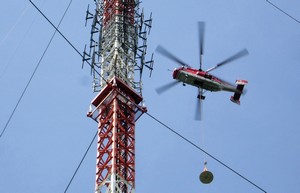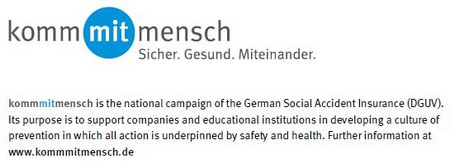Safe operations of helicopters during aerial work
(DGUV Information 214-911)
Information
 | DGUV Deutsche Gesetzliche Unfallversicherung Spitzenverband |
|---|

Stand der Vorschrift: September 2020

| Table of Contents | Abschnitt |
|---|---|
| Preliminary remarks | |
| Scope of application | 1 |
| Terms and Definitions | 2 |
| Fundamental requirements for ensuring aviation and occupational safety | 3 |
| General employer's and insured individuals' duties | 3.1 |
| Operational organisation of aviation and occupational safety | 3.2 |
| Briefings and operating procedures | 3.3 |
| Operational and final briefings | 3.4 |
| Qualification of assignment personnel | 3.5 |
| Personal Protective Equipment (PPE) | 3.6 |
| Occupational medical prophylaxis | 3.7 |
| Inspection of work equipment and Personal Protective Equipment | 3.8 |
| Communication | 3.9 |
| Provision and procurement of working materials for use with helicopters | 4 |
| General requirements | 4.1 |
| Demands on helicopters and their equipment | 4.2 |
| Requirements for Load Lifting Devices (LLD) | 4.3 |
| Other working materials | 4.4 |
| Setting up outside working stations and flight routes | 5 |
| General requirements | 5.1 |
| Load pick-up and load drop-off places | 5.2 |
| Jettisoning and emergency landing places | 5.3 |
| Refueling places | 5.4 |
| Assignment-specific measures | 6 |
| Refueling helicopters | 6.1 |
| Luggage and internal cargo | 6.2 |
| External cargo and installation flights | 6.3 |
| Flights with bulk goods | 6.4 |
| Flights with spray media | 6.5 |
| Inspection flights on overhead power lines and pipelines | 6.6 |
| Measuring flights | 6.7 |
| Fire-fighting/forest fire-fighting flights | 6.8 |
| Photo and film flights | 6.9 |
| Information on the execution of risk assessments | Annex 1 |
| Determining of external load forces | Annex 2 |
| Attaching of external loads | Annex 3 |
| Instructions and briefings | Annex 4 |
| Means of communication | Annex 5 |
| Information on setting up outside working stations | Annex 6 |
| References | 7 |
Preliminary remarks
Helicopter operations of the aerial work category are processes that contain high risks due to the operating conditions. They are an example for the interaction of complicated technology with high mechanical drive performance and manpower in a very confined space.
In case of necessity, for example, the statutory minimum flight heights, the necessary safety heights for an auto-rotation or the safe distances from obstacles are undershot. With various types of work the helicopter may briefly be in a "confined area" situation and the ground personnel are also exposed to a variety of special risks at load pick-up, setting down or assembly points.
Carrying out such work demands professional guidance and management of everyone involved. Work assignments can only be carried out safely by a thorough risk assessment, full use of all possibilities to minimise risks, a targeted choice of appropriate working materials and personnel as well as comprehensive training of the former.
This information gives the employers of aviation companies with the field of application helicopters instructions and recommendations regarding technical, organisational and personnel measures to implement their duties from the statutory occupational safety and health protection regulations or accident prevention regulations. It shows ways of effectively avoiding or minimising accidents at work, occupational diseases and work-related health hazards.
